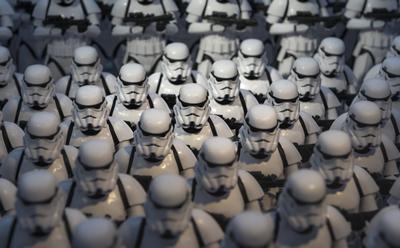Star Wars: a New Hope for franchise longevity

Postgraduate researcher in Film, Adam Vaughan, has written an opinion article for The Conversation on why the Star Wars brand has crossed generations:
Surely it is no overstatement to say that the seventh episode in the Star Wars saga – The Force Awakens – is the most anticipated film of this century so far. Thanks to a marketing campaign that has drip-fed trailers and on-set images over the course of the past 12 months, expectation from fans is at fever pitch. And that’s just the 40-something mums and dads caught up in wistful reverie of their youth.
One of the curiosities of the Star Wars phenomenon is that it all flows from a movie trilogy which ended before younger fans were born. And so what we are left with is a reliance on the advertising of the Star Wars brand and, what we might call a manufactured “vicarious nostalgia” that will see bemused four-year olds unwrapping Boba Fett figurines this Christmas in front of overexcited parents. Disney and Lucasfilm have put in place the ingredients to capture a whole new spectatorship.
Captured! The Conmunity - Pop Culture Geek, CC BY
Making a hit
The original movie – Star Wars: Episode IV - A New Hope – which was released in 1977, was envisioned as a mid-range budgeted “sci-fi” adventure and made for an estimated $11m. According to academic Pam Cook, neither creator/producer/director George Lucas nor production company Fox imagined it doubling its budget at the box office, let alone the $500m it would eventually make by the end of 1980.
However, as innovative and successful as the whizz-bang special effects, outer-space dog fights and blistering sound design were, what set a new precedent for Hollywood filmmaking with Star Wars was the boldness of its merchandising strategy. Action figures, games, T-shirts; all of these movie tie-ins helped fashion Star Wars as a brand that invaded the popular consciousness, and became valued in the billions of dollars as it grew.
Flash Gordon approaches another cliffhanger. Dennis Amith, CC BY-SA
Box office takings and ancillary marketing aside, the effect of nostalgia is crucial to how Star Wars “works” for audiences. It was conceived by Lucas to be a throwback to the science fiction of Saturday morning serials from the 1940s and 1950s, which he had himself grown up watching. The cliffhanger action, archetypal characters, and even the horizontal and vertical screen wipes all contributed to the sense of longing for an earlier and cherished memory of weekends spent in movie theatres. Of course this same feeling would have been experienced by many audience members watching Lucas’s film.
Layers of meaning
First used in the 17th century as a medical diagnosis, “nostalgia” is derived from the Greek “nostos” (to return home) and “algia” (pain). Today its use has evolved to refer to a desire to return to a way of life or a moment with sentimental value, often associated with childhood. Therefore, Lucas’s return to the franchise in the late 1990s with a trilogy of prequels appealed to the generation who had gone with their parents to see the original trilogy – but this time they could take their own children.
The brand remained vibrant during the intervening 20 years. I remember seeing the original three films when they were re-issued in UK cinemas in the mid-90s with my father in anticipation of the release of the fourth film, The Phantom Menace, in 1999. I subsequently pestered my parents every birthday and Christmas for the latest action toy, before meticulously recreating scenes and reinventing others in my bedroom bellowing out John Williams’s now ubiquitous score. I had thus wholeheartedly bought into Lucas’s vision.
And so the saga continues. In 2012 another film merchandising behemoth, The Walt Disney Company, acquired Lucasfilm and it was announced that a new trilogy of Star Wars films, set after the events of Return of the Jedi, were to be made. This week, the new owners will see if the manufactured nostalgia trick has worked its magic as a new generation of fans soaked in peripheral marketing, get to have their own cinema experience. The early signs are that Disney needn’t worry.
The Disney Death Star
The explosion of satellite television channels, and developments in computer game technology since the prequel trilogy has resulted in new and diverse marketing strategies for the Star Wars brand. Key in appealing to the current generation of youngsters to see the new films is animated television series Star Wars: Rebels, screened on the Disney XD channel (Star Wars: The Clone Wars is another series which pre-dates the Disney acquisition).
Furthermore, the original films often enjoy successful re-runs on satellite channels and Episode 1 was re-released into cinemas a few years ago in converted 3D format. More opportunity, then, for parents to pursue this vicarious nostalgia and posit Star Wars as some kind of sacred text to their children, however displaced it might be from the original film.
It boils down to a rigorous and lucrative marketing plan that can continue ad infinitum with each subsequent generation. And it doesn’t end here either.
Kerching… Jose Manuel Ruiz, CC BY-NC-ND
Disney are planning to create a multiverse approach to the new Star Wars films akin to that of their other brand acquisition, Marvel.
As the tagline for The Force Awakens states; “every generation has a story”. However, we could just as easily say that every generation has a Star Wars movie. Will the force be strong enough with this latest stage of the intergalactic saga to entice a whole new audience?
Adam Vaughan, Postgraduate Researcher, University of Southampton
This article was originally published on The Conversation. Read the original article.


